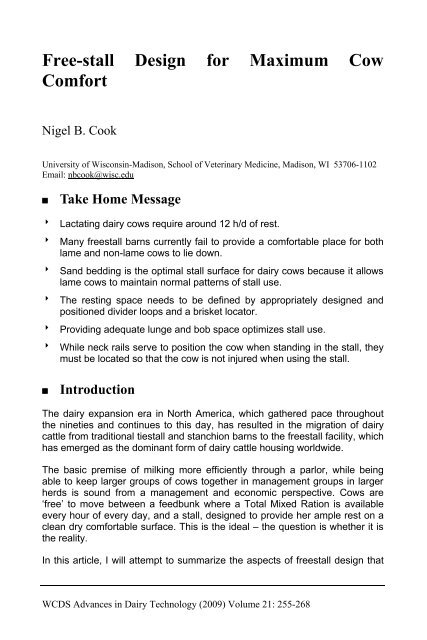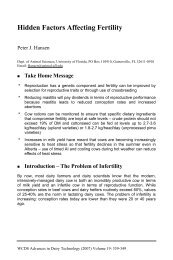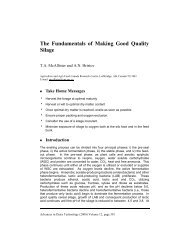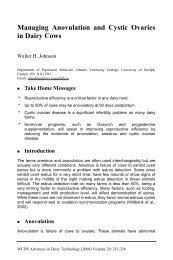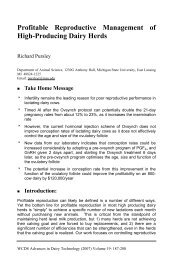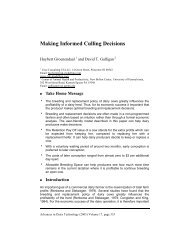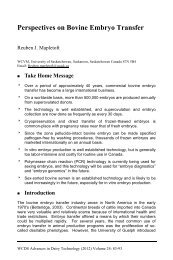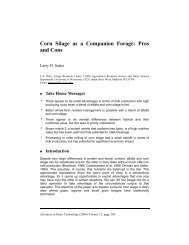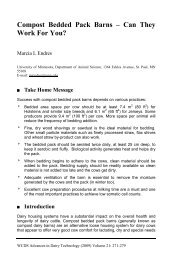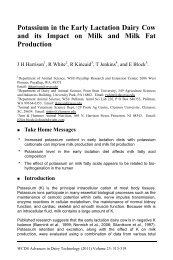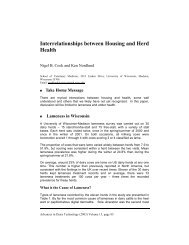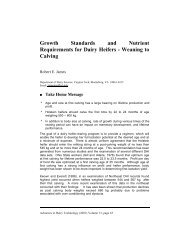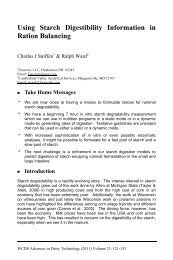You also want an ePaper? Increase the reach of your titles
YUMPU automatically turns print PDFs into web optimized ePapers that Google loves.
<strong>Free</strong>-<strong>stall</strong> <strong>Design</strong> <strong>for</strong> <strong>Maximum</strong> <strong>Cow</strong>Com<strong>for</strong>tNigel B. CookUniversity of Wisconsin-Madison, School of Veterinary Medicine, Madison, WI 53706-1102Email: nbcook@wisc.edu• Take Home Message8 Lactating dairy cows require around 12 h/d of rest.8 Many free<strong>stall</strong> barns currently fail to provide a com<strong>for</strong>table place <strong>for</strong> bothlame and non-lame cows to lie down.8 Sand bedding is the optimal <strong>stall</strong> surface <strong>for</strong> dairy cows because it allowslame cows to maintain normal patterns of <strong>stall</strong> use.8 The resting space needs to be defined by appropriately designed andpositioned divider loops and a brisket locator.8 Providing adequate lunge and bob space optimizes <strong>stall</strong> use.8 While neck rails serve to position the cow when standing in the <strong>stall</strong>, theymust be located so that the cow is not injured when using the <strong>stall</strong>.• IntroductionThe dairy expansion era in North America, which gathered pace throughoutthe nineties and continues to this day, has resulted in the migration of dairycattle from traditional tie<strong>stall</strong> and stanchion barns to the free<strong>stall</strong> facility, whichhas emerged as the dominant <strong>for</strong>m of dairy cattle housing worldwide.The basic premise of milking more efficiently through a parlor, while beingable to keep larger groups of cows together in management groups in largerherds is sound from a management and economic perspective. <strong>Cow</strong>s are‘free’ to move between a feedbunk where a Total Mixed Ration is availableevery hour of every day, and a <strong>stall</strong>, designed to provide her ample rest on aclean dry com<strong>for</strong>table surface. This is the ideal – the question is whether it isthe reality.In this article, I will attempt to summarize the aspects of free<strong>stall</strong> design thatWCDS Advances in Dairy Technology (2009) Volume 21: 255-268
<strong>Free</strong>-<strong>stall</strong> <strong>Design</strong> <strong>for</strong> <strong>Maximum</strong> <strong>Cow</strong> Com<strong>for</strong>t 257will stand after a lying bout, defecate or urinate, and lie back down again onthe contra-lateral side.From studies designed to make cattle work <strong>for</strong> access to a place to rest, itwould appear that cows target around 12 h/d target lying time (Jensen et al.,2005; Munksgaard et al., 2005), and this is in agreement with the lying timesfound in well designed free<strong>stall</strong> facilities (Cook et al., 2004). If this is the case,then our industry is failing to provide the average cow sufficient rest, and ourfree<strong>stall</strong> ideal is not being realized.• What is the Cost of Inadequate Rest?It is commonly suggested that cows make more milk when they are lyingdown as blood flow through the external pudic artery increases by around 24-28% when lying compared to standing up (Metcalfe et al., 1992; Rulquin andCaudal, 1992), and failure to achieve adequate rest has negative impacts onlameness (Cook and Nordlund, in press), ACTH concentrations (Munksgaardand Simonsen, 1996), cortisol response to ACTH challenge (Munksgaard etal., 1999) and growth hormone concentrations (Munksgaard and Løvendahl,1993; Ingvartsen et al., 1999) – suggesting that there is a significant stressresponse.Some workers have suggested that there is a linear relationship between timelying and milk production of the order of 2-3.5 lbs of milk increase <strong>for</strong> eachadditional hour of rest (Grant, 2004). While this may be true, we have notseen such a relationship and milk yield has not been significant in any of thelying time models in our time budget studies.It seems more likely that the requirement <strong>for</strong> rest is a threshold event and thatall cows, regardless of yield, require a minimum period. A strong case can bemade that the true cost of failing to achieve this rest is an increase inlameness, and lameness has significant impacts on production.Let us take a look at mature equivalent (ME305) milk production (whichstandardizes milk output to 3 rd parity) and see how well older cows per<strong>for</strong>mcompared to younger cows – as a proxy measure of how successful ourlameness management is. ME305 averages <strong>for</strong> two groups of herds usingWisconsin DHIA testing – less than 100 cows (which we will assume arepredominantly tie<strong>stall</strong> housed) and greater than 500 cows (which we willassume are free<strong>stall</strong> housed) are shown in Table 2. There are someinteresting trends in the difference between second and later lactation groupsand first lactation groups. While the free<strong>stall</strong> housed larger herds make moremilk, and the difference in ME between first and second parity is similar(~250kg) between both herd size groups, the difference between 1 st lactationand 3 rd and greater lactation cows is much wider in the large herd category –
258 Cooknearly 600 kg greater. If this were due to a failure of the ME calculation toproperly account <strong>for</strong> parity effects, we would expect the differences to beconsistent across herd size. They are not and I believe that the greaterdifferences we are seeing in larger herds are due to the environment in whichwe are keeping the animals. Significant differences in lameness prevalencehave been recorded between tie<strong>stall</strong> and free<strong>stall</strong> barns (Wells et al., 1993;Bergsten and Herlin, 1996; Cook, 2003; Sogstad et al., 2005), and there isevidence to suggest that the free<strong>stall</strong> environment is failing the larger oldercows in our herds – lameness being the primary reason <strong>for</strong> the disparity in MEmilk production. In barn remodels, where we provide more com<strong>for</strong>table <strong>stall</strong>s<strong>for</strong> older mature cows, we see the ME gap close and sometimes invert. Thisoccurs coincident with a decrease in lameness prevalence, particularly inolder cows.Table 2. ME305 averages by parity group <strong>for</strong> DHIA herds by herd size(500 cows) in Wisconsin. Benchmarks April 1, 2008(AgSource Cooperative Services, Verona, WI).Parity GroupMature Equivalent 305 Milk Production (kg)Herds 500 cows (n=155)Average Differencefrom 1 st LactAverage Differencefrom 1 st Lact1 st Lactation 10,410 - 13,220 -2 nd Lactation 10,170 240 12,937 2833 rd+ Lactation 9,935 475 12,174 1,046So, what can we do to improve the situation? We can certainly make sure thatthere is adequate time <strong>for</strong> rest by limiting time out of the pen <strong>for</strong> milking,providing enough <strong>stall</strong>s <strong>for</strong> cows to achieve their target rest by limitingoverstocking and finally, by making sure that the <strong>stall</strong> is com<strong>for</strong>table and easyto use. Indeed, we have used the ME gap theory described above to helpjustify many <strong>stall</strong> renovation projects.• The Importance of Stall SurfaceAnalysis of our time budget database highlights the importance of <strong>stall</strong>surface. <strong>Cow</strong>s bedded on sand exceeded our target of 12 h/d of rest, whilecows on rubber crumb filled mattresses averaged only 10.7 h/d (Figure 1).
<strong>Free</strong>-<strong>stall</strong> <strong>Design</strong> <strong>for</strong> <strong>Maximum</strong> <strong>Cow</strong> Com<strong>for</strong>t 259Hours per day24201612841.82.94.62.212.43.72.64.42.510.7Time Up in StallTime MilkingTime FeedingTime in Alley(incl. drinking)Time Lying0SandMattressFigure 1. Time budgets <strong>for</strong> cows bedded on sand (n=89) compared withcows on a rubber crumb filled mattress (n=119).The reason <strong>for</strong> this is two-fold. Firstly, there are on average 42% fewer lamecows in sand bedded free<strong>stall</strong> herds (Cook, 2003, Cook et al., 2004, Espejo etal., 2006), and secondly, lame cows stand <strong>for</strong> longer in mattress <strong>stall</strong>scompared to sand <strong>stall</strong>s. We believe that the main reason <strong>for</strong> this is due to thedifficulties lame cows have rising and lying down on a firm surface (Cook andNordlund, In Press). Sand provides cushion, traction and support – whichfacilitates rising and lying movements <strong>for</strong> lame cows, enabling them tomaintain normal patterns of rest. Alternatively, firm mattress surfaces make itdifficult <strong>for</strong> cows to rise and lie down because of the pain associated with thecontact point between a painful foot and a firm un<strong>for</strong>giving surface. As aresult, we see an extension in standing time per day, a reduction in thenumber of visits to a <strong>stall</strong> per day and as a consequence of three times a daymilking and other stresses to the cow’s time budget, a reduction in lying time.Failure to provide adequate rest and recuperation <strong>for</strong> lame cows results inchronic disease and an increase in the prevalence of lameness.The difference in lameness prevalence is the main reason <strong>for</strong> the largedifference in milk production observed between sand and mattress free<strong>stall</strong>s(Table 3), but there are also benefits in terms of milk quality. The numberspresented in Table 3 are <strong>for</strong> herds visited because of an udder healthproblem. However, the differences observed are very typical of the mattressto sand conversions we have been involved in over the last 5 years and weuse these figures <strong>for</strong> the construction of partial budgets to finance the barnchanges.
<strong>Free</strong>-<strong>stall</strong> <strong>Design</strong> <strong>for</strong> <strong>Maximum</strong> <strong>Cow</strong> Com<strong>for</strong>t 261Firstly; direct observation. Anderson (2003) examined the ergonomics of <strong>stall</strong>design and showed how limited resting space increased the disturbancesbetween neighbors and led to more restless lying behavior. Secondly;behavioral studies. The <strong>stall</strong> behavior studies described by Tucker et al.(2004) used 15 Holstein cows averaging ~ 1,600 lbs (727 kg) body weight andshowed a significant increase in resting time between 44 inch (112 cm) and48 inch (122 cm) wide <strong>stall</strong>s, but no difference between 48 (122 cm) and 52inches (132 cm), proving that width does have a significant effect on lyingbehavior, and supporting wider dimensions than the industry standard of ~45inches (114 cm). Thirdly; herd per<strong>for</strong>mance changes after <strong>stall</strong> remodeling.We have remodeled a large number of free<strong>stall</strong> facilities in the Upper Mid-West over the last 5 years and my experience has been that after <strong>stall</strong> surfacechanges, increased <strong>stall</strong> width <strong>for</strong> large mature Holstein cows has been thesecond most important change made in both sand and mattress facilities.There is a commonly held belief that if we make the <strong>stall</strong> wider and longer, itwill lead to increased manure contamination of the <strong>stall</strong>, inappropriate <strong>stall</strong>use behavior (eg. backwards lying) and worsening udder health. If the <strong>stall</strong> isnot sized appropriate <strong>for</strong> the size of the animals using them and if the restingarea is poorly defined, these concerns may well be realized. It is there<strong>for</strong>eimportant to determine the size of the animals using the pen, and to designthe resting space correctly. Problems do occur when mixed age groups arepenned together. While small heifers in larger <strong>stall</strong>s may well soil the plat<strong>for</strong>mmore, it makes no sense to punish two thirds of a pen of mature cows tomake sure the <strong>stall</strong>s are kept clean <strong>for</strong> the heifers. A compromise must bereached – either with <strong>stall</strong> dimensions or cow grouping strategy.Diagonal lying is a complex behavioral issue resulting from a variety of <strong>stall</strong>design faults, but <strong>stall</strong> width is often blamed. I believe that the most significantissues leading to diagonal lying are unrelated to <strong>stall</strong> width – they includeadjacent cows in head to head <strong>stall</strong>s (Anderson, 2003), too short a restingspace length, brisket locators that are too high, inadequate lunge space, headbob restrictions and neck rails that are too close to the rear curb (Cook andNordlund, 2005). Failure to understand these causative factors results inpoorly designed <strong>stall</strong>s where cows become contaminated with manure.There<strong>for</strong>e, we need to make sure that the resting area is correctly defined sothat manure contamination of the bed can be minimized.• Defining the Resting AreaThe <strong>stall</strong> resting space is defined laterally by the divider loop and in front bythe brisket locator. We need to provide just enough direction to align the cowcorrectly in the <strong>stall</strong>, but not inhibit the boundaries of the area so much thatlying and rising behavior has to be modified to the point that it reduces theability of the cow to use the <strong>stall</strong>. For these reasons, we prefer a divider loop
262 Cookthat has the following characteristics (Figure 2):8 Locates the upper edge of the lower divider rail at 12 inches (30 cm)above the <strong>stall</strong> surface. This serves to align the cow, enables the cow tolunge easily to the side over the top of the rail if she chooses to do so,and is high enough to reduce trauma to the front leg below the rail andlimit cows putting their legs through the loop.8 Has an angle in the lower rail that is located 20 inches (51 cm) behind acorrectly located brisket locator. This location serves to align the cow, butlimits trauma to the hip area.8 Has an interior loop diameter of 35 inches (89 cm) (or exterior diameter of39 inches (99 cm)). This will make sure that with the lower rail correctlylocated, the upper rail will place the neckrail at around 50 inches (127 cm)above the <strong>stall</strong> surface.The resting space is defined in front by the brisket locator, which serves toposition the cow when she is resting, so that her rear end is adjacent to thealleyway to reduce soiling of the bedding. Behavioral studies have shown thatcows prefer to lie in <strong>stall</strong>s without a brisket locator, compared to <strong>stall</strong>s with an8 inch (20 cm) high piece of wood (Tucker et al., 2006). Many consultantshave taken this to mean that we should build <strong>stall</strong>s without brisket locators.This is a mistake. While I will concede that in a short <strong>stall</strong> (less than 8 feet(2.44 m)), a poorly designed brisket locator can be removed resulting in anobservable improvement in <strong>stall</strong> usage, larger <strong>stall</strong>s require a locator to helpposition the cow.Total Stall LengthLength from rear curb to neck rail9 - 12"Divider loopinternal diameter = 35"Neck rail 44-52”above bedding surface5" MinMax 12" from <strong>stall</strong>surface to top oflower divider rail20" from top ofbrisket locator toangle of lowerdivider railFigure 2. An ideal divider loop positioned relative to the rear curb andbrisket locator.
<strong>Free</strong>-<strong>stall</strong> <strong>Design</strong> <strong>for</strong> <strong>Maximum</strong> <strong>Cow</strong> Com<strong>for</strong>t 263The problem with brisket locator design is the movement of the cow’s front legwhen she is rising in the <strong>stall</strong>. To facilitate rising, she needs to take a full<strong>for</strong>ward stride and to do this, it is difficult <strong>for</strong> most cows to lift their leg muchhigher than about 4 inches (10 cm) above the <strong>stall</strong> surface. Generally, wehave moved away from the traditional brisket board (a wooden <strong>for</strong>m used topour the concrete curb), to more rounded plastic, fiber glass or pvc pipes ormouldings. These have per<strong>for</strong>med reasonably well, but because they arelower, smoother and less restrictive, some cows choose to ignore them.Because of these issues, we have returned to concrete <strong>for</strong> the answer and Ihave developed a design that we call the ‘brisket slope’. This serves to locatethe cow, while being low enough to allow the cow to lie down with her frontlegs outstretched, and sloped enough to allow the front leg to land on theslope when rising (Figure 3).3.5" above rear lip ofcurb8" high curb alleyside6" wide withrounded edges6" high interiorcurb7" height to start of gradualslope11.5" <strong>Maximum</strong>Height68-72"Figure 3. The concrete brisket slope – designed to locate the cowrelative to the rear curb, allow her to stretch her legs <strong>for</strong>ward and planther front leg <strong>for</strong>ward when she rises.• Providing Adequate Lunge and Bob SpaceWhen the cow rises, she moves her head <strong>for</strong>ward in a lunging motion to takethe weight off her rear legs to facilitate rising. The head is lowered, almost tothe surface she is resting on and then bobs upward. We refer to the horizontalarea in front of the resting space as lunge space and the vertical area at theend of the lunge as the bob zone.Failure to provide adequate lunge and bob space may not result in a dramaticreduction in <strong>stall</strong> occupancy, but it does alter the way cows use the <strong>stall</strong>s insubtle ways. Tucker et al. (2004) found no effect on lying times <strong>for</strong> ~1600 lb(727 kg) cows housed in <strong>stall</strong>s 90 inches (2.29 m) long or 108 inches (2.74 m)long. There are three possible reasons <strong>for</strong> this: a) it doesn’t matter, b) neitherof the choices were long enough <strong>for</strong> front lunge (our recommendation is <strong>for</strong>cows weighing ~1600 lbs (727 kg) to be housed in <strong>stall</strong>s 120 inches (3.05 m)long), or c) the cows could side lunge because the lower divider loop rail wascorrectly located to allow this option. I believe that b and/or c are the most
264 Cooklikely explanations.Having seen the results of numerous barns that have extended side walls toallow 9.5-10 feet (~3.0 m) long side wall <strong>stall</strong>s, I am convinced that it doesmake a difference, especially <strong>for</strong> the largest oldest cows on the farm. I amalso convinced that some cows will want to side lunge and we should allowthat as an option. This is particularly true of head to head <strong>stall</strong>s. The presenceof one cow in front of another adds an element of uncertainty in <strong>stall</strong> design inthat some cows will not lie straight or lunge into a cow facing her. This leadsto diagonal lying and side lunging. This also has an effect on how clean the<strong>stall</strong>s are if we change <strong>stall</strong> dimensions. In order to maximize width, withoutrunning into diagonal lying issues, we must provide adequate length <strong>for</strong> frontlunge. For mature Holstein cows that means <strong>stall</strong>s that are 10 feet (3.05 m)long facing a wall and at least 17 feet (5.18 m) head to head (Figure 4).Resting areaLunge areaResting areaLunge area50”45”50”15’16’17-18’96”66”96”66”120”72”a b ca b cFigure 4. Lying position in head to head and side wall facing <strong>stall</strong>s andhow it is influenced by <strong>stall</strong> width and length and the presence of asocial obstruction in front of the <strong>stall</strong>.• Locating the Neck RailThe neck rail serves to provide lateral stability to the divider loops whilehelping to position the cow while standing in the <strong>stall</strong> relative to the rear curb.It is important to realize that the cow on pasture rises and ends up standing 2-3 feet (60-90 cm) in front of where she was lying. There<strong>for</strong>e, wherever weplace the neck rail, it will be in the way of the cow – even if it is ‘floating’ or ismade of some other material other than metal. The trick is to locate it so thatthe cow can cope and adjust and take a step backward, rather than a step<strong>for</strong>ward when she rises. Neck rails do not influence lying time much, but theydo influence standing behavior when located between 55 inches (140 cm) and92 inches 234 cm) from the rear curb and between 40 inches (102 cm) and 50inches (127 cm) above the <strong>stall</strong> surface (Tucker et al., 2005), with lower railscloser to the rear curb increasing the amount of perching (standing half in andhalf out of the <strong>stall</strong>) observed. We associate these neck rail locations with agreater risk <strong>for</strong> injury also.
<strong>Free</strong>-<strong>stall</strong> <strong>Design</strong> <strong>for</strong> <strong>Maximum</strong> <strong>Cow</strong> Com<strong>for</strong>t 265Neck rails that are located too far <strong>for</strong>ward increase soiling of the <strong>stall</strong> bed andfrequently farmers respond by moving the rail back closer to the curb.However, if there is insufficient space to rise com<strong>for</strong>tably below and behindthe neck rail, cows have difficulty standing without hitting the rail – which isjust unacceptable. While a contaminated <strong>stall</strong> maybe a risk <strong>for</strong> udder infection,an unused <strong>stall</strong> is most definitely a risk <strong>for</strong> inadequate rest, lamenessproblems and early herd removal. We there<strong>for</strong>e have to find the right balancebetween com<strong>for</strong>t and cleanliness.Neck rail location recommendations are different in mattress and sand <strong>stall</strong>sbecause the raised rear curb modifies the way cows stand in the <strong>stall</strong> – theyare reluctant to stand on a raised concrete curb. Neck rails are located inmattress <strong>stall</strong>s directly above the correctly located brisket locator – so that thecow is able to stand squarely in the <strong>stall</strong>, but in deep bedded <strong>stall</strong>s with araised rear curb, where the neck rail is at least 48 inches (122 cm) above thesurface, we move the rail back a distance equivalent to the width of the rearcurb, so that the cow takes a step back and perches half in and half out of the<strong>stall</strong>. While we will not tolerate this behavior in a flat, mattress <strong>stall</strong>, we areprepared to tolerate it in a deep loose bedded <strong>stall</strong>, because the front footelevation is much less and the problems of managing a deep bed soiled withurine and feces are too great. While there is some evidence to suggestextended time perching increases the risk <strong>for</strong> lameness (Weary, personalcommunication), this does not seem to be a factor in sand <strong>stall</strong>s as 90% ofthe <strong>stall</strong> standing behavior is perching (Cook et al., 2005) and lamenessprevalence is almost half of that on mattresses. This probably relates to thefact that <strong>stall</strong> standing time is about half in sand <strong>stall</strong>s compared with mattress<strong>stall</strong>s.Table 4. Target <strong>stall</strong> dimensions (cm) <strong>for</strong> cows of different body weightestimates.Body Weight Estimate (kg)Stall Dimension (cm) 455 545 636 727 818Total <strong>stall</strong> length facing a wall 244 244 274 305 305Distance from rear curb to brisket locator 163 168 173 178 183Center-to-center <strong>stall</strong> divider placement (Stall 112 117 122 127 137width)Height of brisket locator above <strong>stall</strong> surface 8 8 10 10 10Height of upper edge of bottom divider rail 28 28 30 30 30above <strong>stall</strong> surfaceHeight below neck rail 112 117 122 127 132Horizontal distance between rear edge of neck 163 168 173 178 183rail and rear point of the curb <strong>for</strong> mattress <strong>stall</strong>sRear curb height 20 20 20 20 20
266 Cook• ConclusionI believe that <strong>stall</strong> designs which were commonplace in free<strong>stall</strong> barns up untila few years ago are failing the cow and our industry in terms of per<strong>for</strong>mance,health and well-being. We can and should do better, and it is economical todo so. Numerous barn renovations have proven this to be the case. However,doing what is right <strong>for</strong> the cow is not solely an economic question. Welfarehas never been and never will be an argument based on economics. It is aduty that transcends such discussion. Fortunately, the balance of welfare andeconomics are in alignment when we consider improvements to cow com<strong>for</strong>t.It is true to say that when we make <strong>stall</strong>s bigger, there is greater risk <strong>for</strong>design error, leading to diagonal lying and manure contamination of the <strong>stall</strong>bed. However, it is also true that a ‘one size fits all policy of restraint’ has alsofailed. In this discussion, I have detailed the common errors made whenmaking <strong>stall</strong>s bigger – using the wrong divider loop, not using a brisket locatoror using a poorly designed one, failing to understand the importance of<strong>for</strong>ward lunge and bob space to lying position and locating the neck railincorrectly. Such problems are common because builders and dairyproducers have not built such large <strong>stall</strong>s be<strong>for</strong>e and there is much confusingmisin<strong>for</strong>mation about new design philosophies. Hopefully this article has putsome of these issues to rest.From the experiences I have been directly involved in, using the designs Ihave discussed here I have little doubt that big sand <strong>stall</strong>s are the ‘best thingever’. Improvements in health, well-being and per<strong>for</strong>mance have been nothingshort of astonishing. I am convinced that these design recommendations willbe the standard <strong>for</strong> building free<strong>stall</strong>s <strong>for</strong> years to come and while I am surethat there will be some teething problems, the future <strong>for</strong> a dairy industry thatuses them looks bright <strong>for</strong> the cows and their owners, and that we can find theright compromise between cow com<strong>for</strong>t and cleanliness.• ReferencesAnderson, N. 2003. Dairy cattle behavior: <strong>Cow</strong>s interacting with theirworkplace. Pages 10-22 in Proc. 36th Annual Convention AmericanAssociation of Bovine Practitioners, Columbus, Ohio.Bergsten, C., and A.H. Herlin. 1996. Sole hemorrhages and heel horn erosionin dairy cows: The influence of housing system on their prevalence andseverity. Acta Veterinaria Scandinavia 37, 395-408.Cook, N.B. 2003. Prevalence of lameness among dairy cattle in Wisconsin as afunction of housing type and <strong>stall</strong> surface. Journal of American VeterinaryMedical Association 223, 1324-1328.
<strong>Free</strong>-<strong>stall</strong> <strong>Design</strong> <strong>for</strong> <strong>Maximum</strong> <strong>Cow</strong> Com<strong>for</strong>t 267Cook, N.B., T.B. Bennett, and K.V. Nordlund. 2004. Effect of free <strong>stall</strong> surfaceon daily activity patterns in dairy cows, with relevance to lamenessprevalence. J. Dairy Sci. 87:2912-2922.Cook, N. B., and K. V. Nordlund. 2005. An update on dairy cow free<strong>stall</strong>design. Bovine Practitioner 39:29-36.Cook, N.B., T.B. Bennett, and K.V. Nordlund. 2005. Monitoring indices of cowcom<strong>for</strong>t in free-<strong>stall</strong> housed dairy herds. . J. Dairy Sci. 88, 3876-3885.Cook, N.B. and D. Reinemann. 2007. A tool box <strong>for</strong> assessing cow, udder andteat hygiene. Pages 31-43 in 46 th Natl. Mastitis Counc. Mtg. Proc. SanAntonio, Texas. Natl. Mastitis Counc., Inc., Madison, WI.Cook, N.B., and K.V. Nordlund. In press. The influence of the environment ondairy cow behavior, claw health and herd lameness dynamics. Vet. J.doi:10.1016/j.tvjl.2007.09.016.Espejo, L.A., and M.I. Endres. 2007. Herd-level risk factors <strong>for</strong> lameness inhigh-producing Holstein cows housed in free<strong>stall</strong> barns. J. Dairy Sci.90:306-314.Grant, R. 2004. Taking advantage of natural behavior improves dairy cowper<strong>for</strong>mance. Accessed 08/22/08 at http://www.extension.org .Ingvartsen, K.L., L. Munksgaard, V.K.M. Nielsen and L. Pedersen. 1999.Responses of repeated deprivation of lying down on feed intake,per<strong>for</strong>mance and blood hormone concentration in growing bulls. Acta.Agric. Scans. A Anim. Sci. 49:260-265.Jensen, M.B., L.J. Pedersen, and L. Munksgaard. 2005. The effect of rewardduration on demand functions <strong>for</strong> rest in dairy heifers and lyingrequirements as measured by demand functions. Appl. Anim. Behav.Sci. 90:207-217.Metcalfe, J.A., S.J. Roberts, and J.D. Sutton. 1992. Variations in blood flow toand from the bovine mammary gland measured using transit timeultrasound and dye dilution. Res. Vet. Sci. 53:59-63.Munksgaard, L., L. Ingvartsen, L.J. Pedersen, and V.K.M. Nielsen. 1999.Deprivation of lying down affects behavior and pituitary-adrenal axisresponses in young bulls. Acta. Agric. Scand. A Anim. Sci. 49:172-178.Munksgaard, L., and P. Løvendahl. 1993. Effect of social and physicalstressors on growth hormone levels in dairy cows. Can. J. Anim. Sci.73:847-853.Munksgaard, L., and H.B. Simonsen. 1996. Behavioral and pituitary adrenalaxisresponses of dairy cows to social isolation and deprivation of lyingdown. J. Anim. Sci. 74:769-778.Munskgaard, L., M.B. Jensen, L.J. Pedersen, S.W. Hansen, and L. Matthews.2005. Quantifying behavioural priorities-effects of time constraints onbehavior of dairy cows. Appl. Anim. Behav. Sci. 92:3-14.Phillips, C.J.C., and M.I. Rind. 2001. The effects on production and behaviourof mixing uniparous and multiparous cows. J. Dairy Sci. 84:2424-2429.Rulquin, H., and J.P. Caudal. 1992. Effects of lying or standing on mammaryblood flow and heart rate of dairy cows. Ann. Zootech. (Paris) 41:101.
268 CookSogstad, A.M., T. Fjeldaas, O. Osteras, and K. Plym Forshell. 2005.Prevalence of claw lesions in Norwegian dairy cattle housed in tie <strong>stall</strong>sand free <strong>stall</strong>s. Preventive Veterinary Medicine 70, 191-209.Tucker, C.B., D.M. Weary, and D. Fraser. 2004. <strong>Free</strong>-<strong>stall</strong> dimensions: effectson preference and <strong>stall</strong> usage. J. Dairy Sci. 87:1208-1216.Tucker, C.B., D.M. Weary, and D. Fraser. 2005. Influence of neck railplacement on free<strong>stall</strong> preference, use and cleanliness. J. Dairy Sci.88:2730-2737.Tucker, C.B., G. Zdanowicz, and D.M. Weary. 2006. Brisket boards reducefree<strong>stall</strong> use. J. Dairy Sci. 89:2603-2607.Wells S.J., A.M. Trent, W.E. Marsh, and R.A. Robinson. 1993. Prevalenceand severity of lameness in lactating dairy cows in a sample ofMinnesota and Wisconsin dairy herds. Journal of American VeterinaryMedical Association 202, 78-82.
269FINDING A WAY FORALBERTA’S DAIRYPRODUCERSVisit your local branch,call us at 1-800-332-8383,or visit atb.com
270A SLAT RUBBER SYSTEM PROVEN TO SUCCEEDDIAMOND PATTERNSURFACE• Extremely durable• Reduces slip• Scrapers glide easilyover itBUILT INSLOPE• Promotes cleanliness• Keeps mat clearFor all typesof new &existing slatsReduce lameness –and your treatment costs!WEDGE• Easy to in<strong>stall</strong>• Securely grips concrete• Doesn’t move, tear or expandAN INTERLOCKING RUBBER MAT SYSTEM THAT WORKSEASY TO INSTALLAND MAINTAIN1M X 1MMATSINTERLOCKTOGETHERTO GIVE ASEAMLESSSURFACE¾” THICKNATURALRUBBER - WILLNOT WARP, TEAROR EXPAND“PENNY GRIP”SURFACE ON BOTHSIDES OF MATWHICH OFFERSDUAL GRIPAND EXCELLENTTRACTIONUse the Max Grip Mat in alleys, milking parlours and holdingareas to improve cow com<strong>for</strong>t and confidence in their foothold.1-877-247-4685www.agsourcing.net“Bringing value...from our farm family to yours!”


